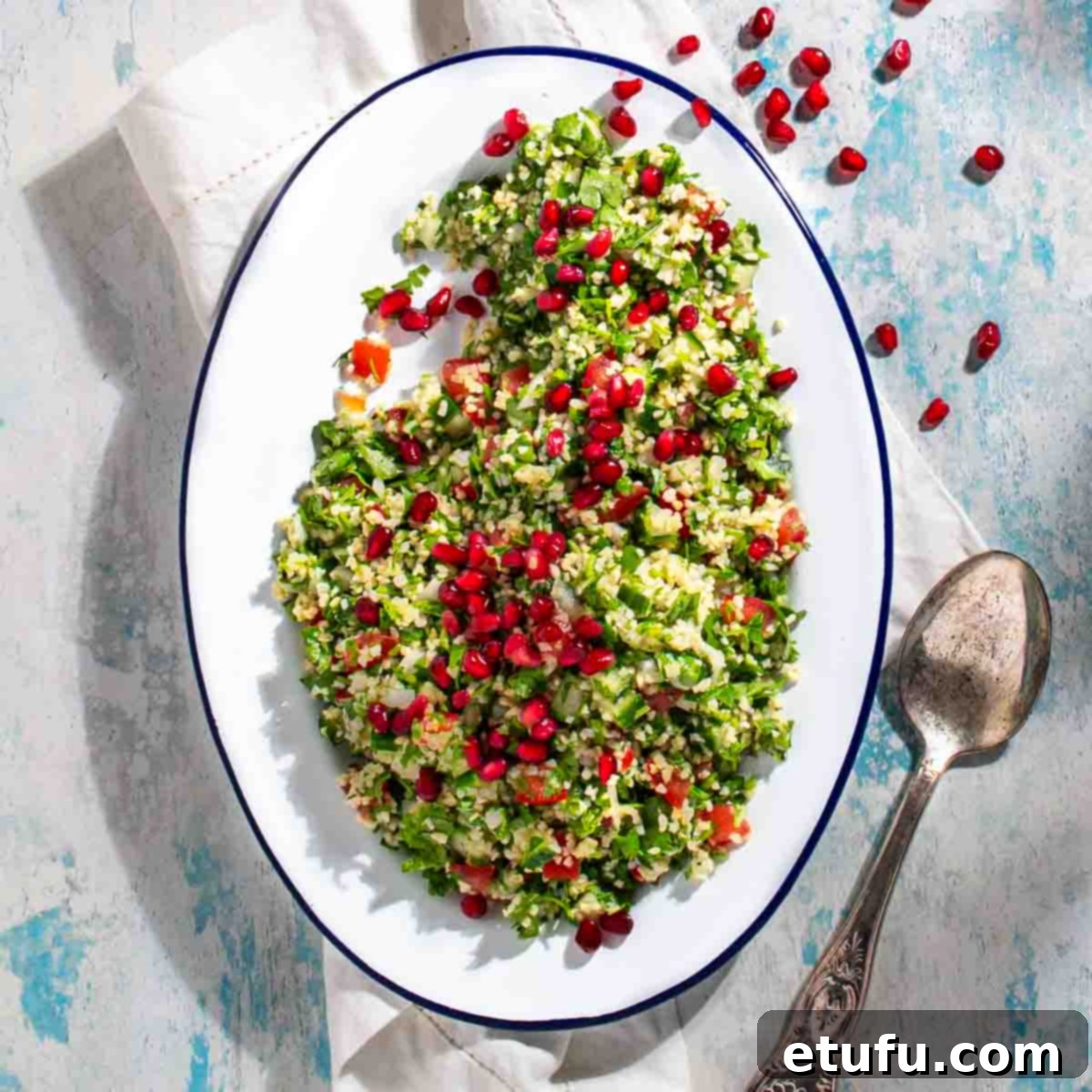Authentic Lebanese Taboule: A Culinary Journey to the Heart of the Mediterranean
Embark on an epicurean adventure to the vibrant landscapes of Lebanon with Taboule, a truly iconic and refreshing salad that has captivated palates for centuries. More than just a dish, Taboule is a celebration of fresh, simple ingredients, embodying the essence of Mediterranean cuisine.
This traditional Lebanese salad, known for its bright flavors and healthful profile, artfully combines finely chopped parsley, ripe tomatoes, crisp onions, refreshing mint, and delicate bulgur wheat. The result is a symphony of textures and tastes that has earned Taboule immense popularity not only across the Middle East but also throughout the entire world.
Depending on regional dialects and preferences, you might encounter various spellings and pronunciations for this beloved salad: Tabouleh, Tabbouli, Tabouli, Taboulah, or even just Tabbouleh salad. Regardless of how you say it, its irresistible charm remains constant.
The origins of Taboule can be traced back to the majestic mountains of Lebanon, where it was first conceived as a clever and delicious way to utilize the abundant supply of fresh, aromatic herbs thriving in the fertile region. Over generations, this humble mountain dish evolved into a culinary cornerstone.
Today, Taboule holds a revered status as a staple in Lebanese gastronomy. It frequently graces tables as a refreshing side dish, a vibrant component of a larger mezze spread, or even as a light and satisfying main course. Its invigoratingly fresh and tangy profile makes it an impeccable companion for virtually any meal, particularly shining brightly at summer gatherings and outdoor festivities.

Fast Facts – Discover Lebanon

| Location | Lebanon is a picturesque country situated in the Middle East. It shares its northern and eastern borders with Syria, its southern border with Israel, and its western coastline is embraced by the beautiful Mediterranean Sea. |
| Language | The official language of Lebanon is Arabic. However, due to its diverse history and cultural influences, French and English are also widely and fluently spoken across the nation. |
| Population | With a population of approximately 6.8 million people, Lebanon is a country rich in human spirit and cultural tapestry. |
| Trivia | Lebanon is renowned globally for its profound history, breathtaking natural landscapes, and exceptionally vibrant culture. It is affectionately referred to as the “Switzerland of the Middle East” owing to its impressive mountainous terrain and popular ski resorts. The nation is equally celebrated for its delectable cuisine, featuring world-famous dishes like creamy hummus, crispy falafel, and, of course, the refreshing Taboule. Furthermore, Lebanon proudly hosts some of the world’s most ancient cities, including Byblos, which boasts an incredible history of continuous habitation spanning over 7,000 years. |
For those seeking more substantial and crowd-pleasing salad options, consider trying this creamy South African potato salad, the always-popular aromatic curry noodle salad, or this exquisite Cypriot grain salad!
Why You’ll Adore This Taboule Recipe
This homemade Taboule recipe is designed to bring the authentic taste of Lebanon right to your kitchen. Here’s what makes it an absolute favorite:
- A Burst of Mediterranean Freshness: Experience the true essence of a healthy and incredibly refreshing Mediterranean salad. It’s light, vibrant, and utterly invigorating.
- Explosive Flavor Profile: Prepare for a delightful flavor explosion! This salad masterfully combines the zingy brightness of fresh lemon with the crisp textures and aromatic goodness of garden-fresh vegetables and herbs.
- Naturally Vegan-Friendly: Crafted entirely from plant-based ingredients, this Taboule recipe is a perfect choice for vegans and those embracing a plant-rich diet, without compromising on taste or satisfaction.
- Effortless Preparation – No Cooking Required: Enjoy the simplicity of a delicious meal that comes together with minimal fuss. There’s absolutely no cooking involved, making it ideal for busy weeknights or a quick, healthy lunch.
- Incredibly Versatile: This Taboule is the ultimate culinary chameleon, perfectly complementing a wide array of main dishes. From grilled meats and fish to vegetarian stews and simple pita bread, it enhances every meal.
- Simple, Wholesome Ingredients: Utilizes straightforward, readily available ingredients that are not only easy to find but also contribute to a wholesome and nutritious dish.
- Perfect for Any Occasion: Whether it’s a casual family dinner, a sophisticated outdoor picnic, or a large celebratory gathering, Taboule is always a welcome and impressive addition.
Key Ingredients and Smart Substitutions for Perfect Taboule
The magic of Taboule lies in the quality and freshness of its components. Here’s a detailed look at the main ingredients and how to choose and prepare them for the best results:

Bulgur Wheat (Cracked Wheat)
Bulgur wheat is the traditional grain component of Taboule. For an authentic texture, fine or medium-grind bulgur is typically preferred. Fine bulgur yields a more delicate, almost couscous-like texture, which blends seamlessly with the herbs and vegetables. Medium-grind bulgur, on the other hand, offers a slightly chewier and more substantial bite, adding a pleasant heartiness to the salad. Your choice often comes down to personal preference, so don’t hesitate to experiment with different grinds to find your ideal texture.
A crucial tip: always opt for good quality bulgur. While quick-cooking or instant bulgur varieties are available in some stores, they are generally not recommended for Taboule. These types can become overly mushy and lose their distinct texture when soaked, which is essential for a well-structured salad.
Tomatoes
The success of your Taboule heavily relies on the quality of your tomatoes. Seek out firm, ripe tomatoes that possess a bright, vibrant color and a sweet, juicy aroma. Popular and excellent choices include vine-ripened tomatoes, Roma tomatoes (known for their firm flesh and fewer seeds), sweet cherry tomatoes, or even heirloom varieties for an extra burst of flavor. To prevent your Taboule from becoming watery and soggy, it is highly advisable to remove the tomato seeds and any excess liquid before finely dicing them. This step is usually easier to achieve with larger tomato varieties.
Cucumber
While not every traditional Taboule recipe includes cucumber, it is a common and welcome addition that contributes a wonderful refreshing crunch and a subtle, cool flavor to the salad. This recipe incorporates cucumber for that extra textural layer, but feel free to omit it if you prefer. Similar to the tomatoes, we recommend removing the watery, fleshy middle part of the cucumber to prevent introducing excess moisture into the salad, ensuring a perfectly balanced consistency.
Parsley: The Star of the Show
Parsley is unequivocally the single most important ingredient in Taboule – it’s not just a garnish, it’s the foundation! Flat-leaf parsley, also known as Italian parsley, is the superior choice. Its robust, peppery flavor and crisp texture are ideal, and its flat leaves make it remarkably easy to finely chop. In contrast, curly parsley has a much more muted flavor and a coarser texture, making it less suitable for this particular dish.
To prepare, simply remove the thick stems from the flat-leaf parsley and chop the leaves finely. This ensures an even distribution of its vibrant flavor and striking green color throughout the salad. If you’ve had authentic Taboule before, you’ll undoubtedly remember that the salad is predominantly green, a testament to the generous quantity of fresh parsley used. The other vegetables and bulgur wheat truly play supporting roles to this verdant hero.
Mint: The Aromatic Accent
Fresh mint leaves are crucial for that signature cooling and aromatic freshness that elevates Taboule. Finely chopped, they provide a bright counterpoint to the parsley and a fragrant lift to the entire dish. Always use fresh mint, as dried mint won’t achieve the same vibrant flavor.
Onion
A small red or brown onion, finely diced, provides a subtle bite and aromatic depth to the Taboule. The key is to chop it very finely so that its flavor integrates seamlessly without overpowering the other delicate ingredients. If you find raw onion too strong, you can soak the diced onion in a little cold water for 10-15 minutes before adding it to the salad; this helps to mellow its sharpness.
Lemon Juice & Extra Virgin Olive Oil
These two ingredients form the simple yet potent dressing that binds the Taboule together and infuses it with its characteristic Mediterranean tang. Always use freshly squeezed lemon juice for the brightest flavor. A good quality extra virgin olive oil is also paramount, as its rich, fruity notes contribute significantly to the overall taste and mouthfeel of the salad.
Salt and Black Pepper
Seasoning is key to bringing out the best in fresh ingredients. Start with the suggested half teaspoon of salt, then adjust to your personal preference after all ingredients have been thoroughly combined. Freshly ground black pepper adds a subtle warmth and depth.
Pomegranate Seeds (Optional but Recommended)
While not strictly traditional in every Taboule, we absolutely adore adding these little ruby-red jewels to the salad! Pomegranate seeds are not only visually stunning, adding a beautiful pop of color, but they also introduce a delightful burst of sweet-tart flavor and a unique textural crunch. You can harvest them fresh from a whole pomegranate fruit, or for ultimate convenience, purchase pre-packaged pomegranate seeds from your local grocery store.
How to Craft Perfect Taboule: A Step-by-Step Guide
Creating this authentic Lebanese Taboule is surprisingly simple and incredibly rewarding. Follow these steps for a vibrant and flavorful salad every time:
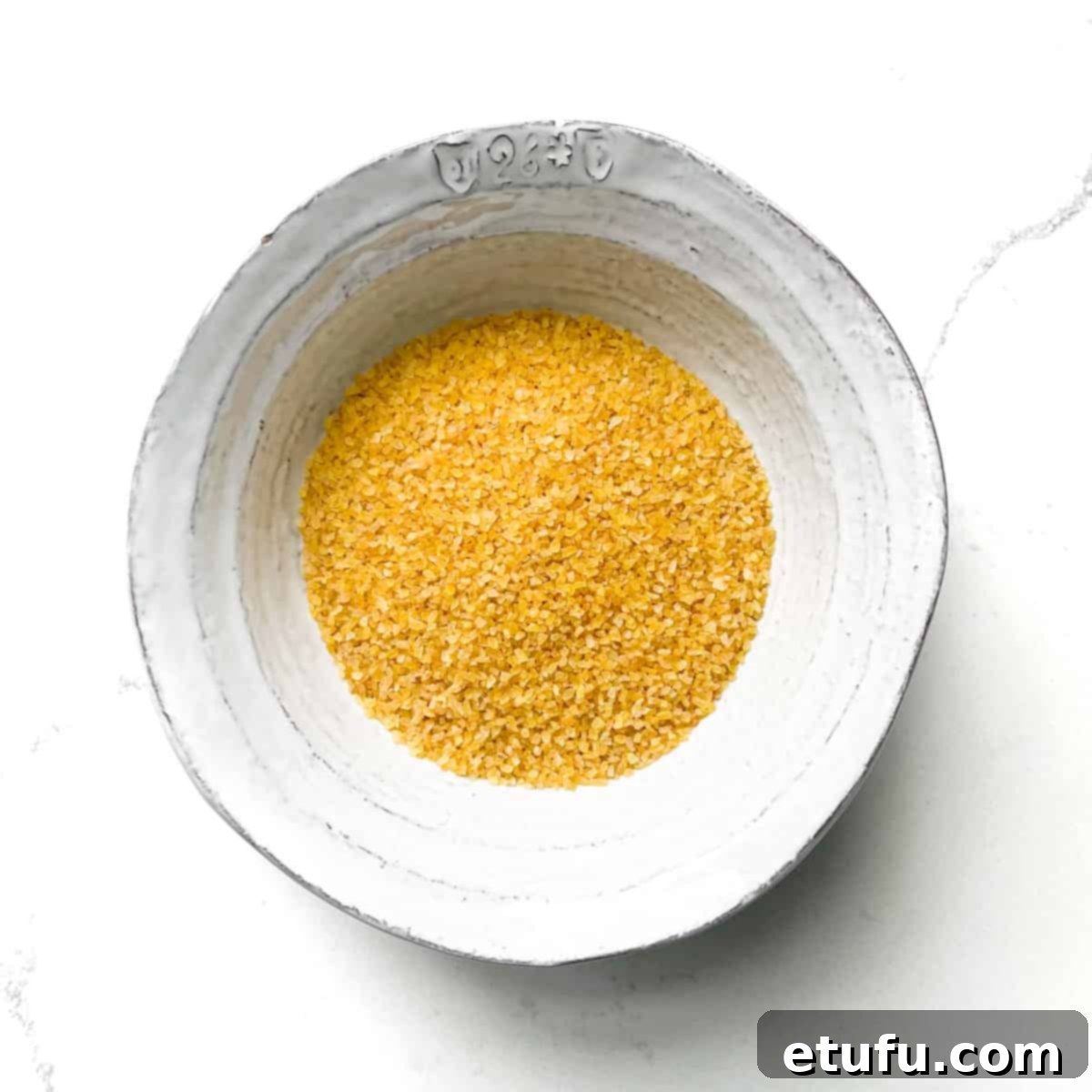
- Prepare the Bulgur Wheat: Begin by adding the specified amount of fine or medium-grind bulgur wheat to a medium-sized heatproof bowl.
- Soak the Bulgur: Carefully pour the boiling water over the bulgur. Ensure the bulgur is fully submerged. Cover the bowl tightly with plastic wrap or a clean kitchen towel. Allow the bulgur to soak undisturbed for 20-30 minutes. This is the perfect time to prepare the rest of your fresh vegetables and herbs. The bulgur will absorb the water and soften, becoming plump and tender.
- Dice the Tomatoes: Slice your tomatoes into quarters. Carefully cut out the fleshy middle part that contains the seeds and excess liquid. Then, dice the firm tomato flesh into small, uniform pieces, roughly 1cm (about ⅓ inch) in size.
Note: This step is crucial! Removing the pulpy center prevents your Taboule from becoming watery and maintains its desired fresh, crisp texture. Refer to the photo above for a visual guide on how to prepare the tomatoes.
- Prepare the Onion: Finely dice the onion into small pieces, similar in size to your tomatoes (approximately 1cm). Aim for consistency to ensure even flavor distribution.
- Chop the Cucumber: If using, slice the cucumber into quarters lengthways. Scoop out and discard the watery, fleshy middle part containing the seeds. Chop the firm cucumber flesh into small pieces, roughly 1cm.
Note: As with the tomatoes, removing the pulpy center of the cucumber is vital to prevent excess liquid from compromising the salad’s texture. The photo above illustrates the ideal preparation.
- Finely Chop the Parsley: With a large, sharp knife or a mezzaluna, finely chop the flat-leaf parsley. Aim for a consistent, fine chop without bruising the leaves too much.
Tip: While a food processor might seem like a shortcut, we strongly advise against using it for the parsley. It tends to over-process and turn the parsley into a mushy paste, losing its desirable crisp texture and vibrant appearance. Hand-chopping ensures the best results.
- Chop the Mint: Similarly, finely chop the fresh mint leaves. This will release their invigorating aroma and flavor.
- Prepare the Dressing: In a small separate bowl, whisk together the extra virgin olive oil, fresh lemon juice, salt, and black pepper. Stir until well combined, forming a cohesive dressing.
- Check the Bulgur Wheat: By now, your bulgur wheat should be soft and plump. Fluff up the grains with a fork. Transfer the bulgur to a large mixing bowl, which will accommodate all the other ingredients.
Tip: If, after soaking, you notice any excess water that hasn’t been absorbed by the bulgur, strain it through a fine-mesh sieve. Gently shake the sieve and use a spoon to move the bulgur around until all remaining liquid has drained away. This ensures your Taboule isn’t soggy.
- Dress the Bulgur: Pour the prepared olive oil and lemon dressing over the fluffed bulgur wheat. Give it a quick, thorough stir to ensure the bulgur is evenly coated with the vibrant dressing.
- Combine Ingredients: Add all the finely diced tomatoes, onions, cucumber, chopped parsley, and chopped mint to the bowl with the dressed bulgur.
- Toss and Season: Gently toss all the ingredients together with the bulgur wheat until everything is thoroughly combined and the colors are beautifully distributed. Taste the salad for seasoning. This is your chance to adjust the salt, adding more if you wish, to perfectly suit your palate.
- Garnish and Serve: Finally, scatter the beautiful pomegranate seeds generously over the finished Taboule just before serving. Enjoy this fresh, authentic Lebanese salad as a centerpiece or a delightful accompaniment to your meal.



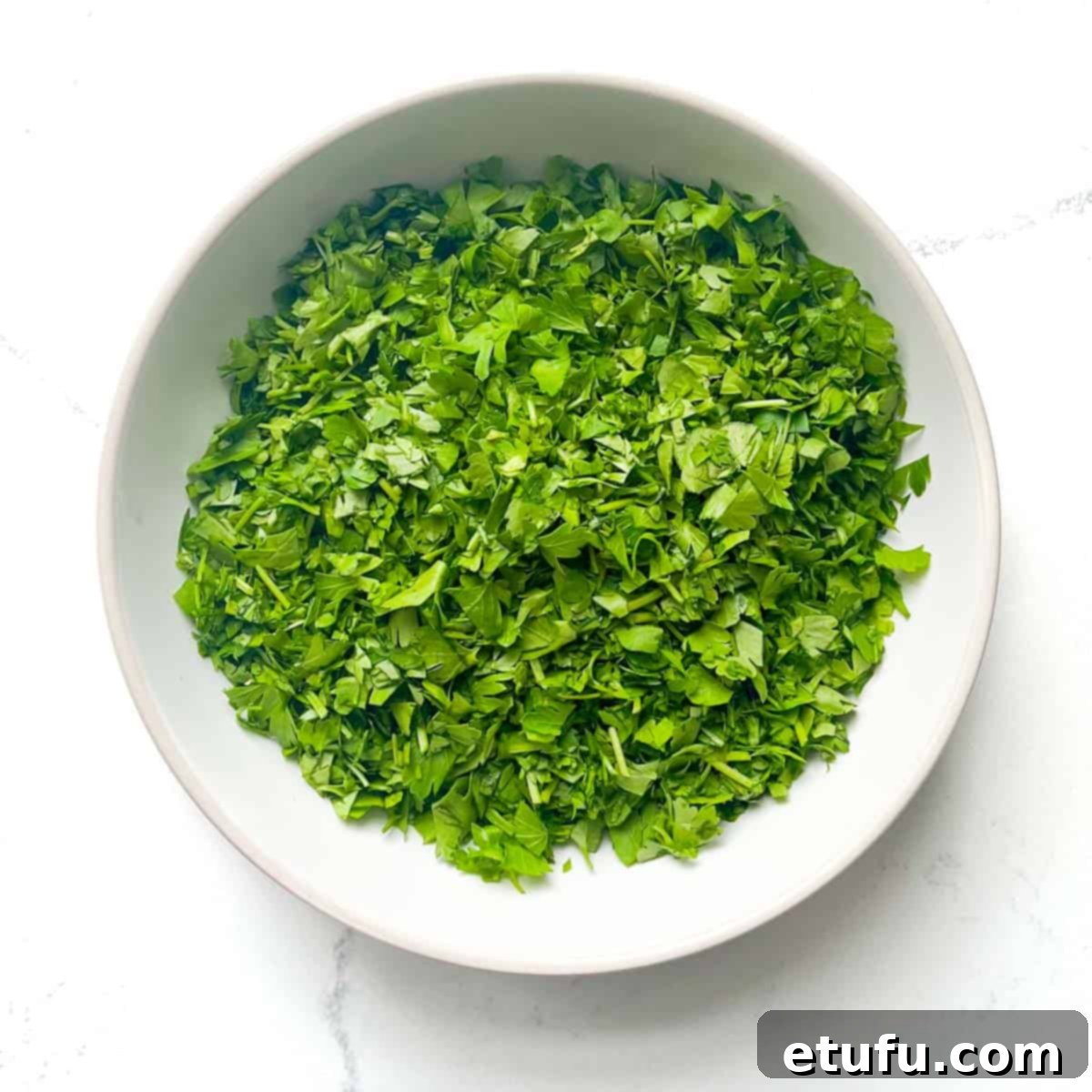
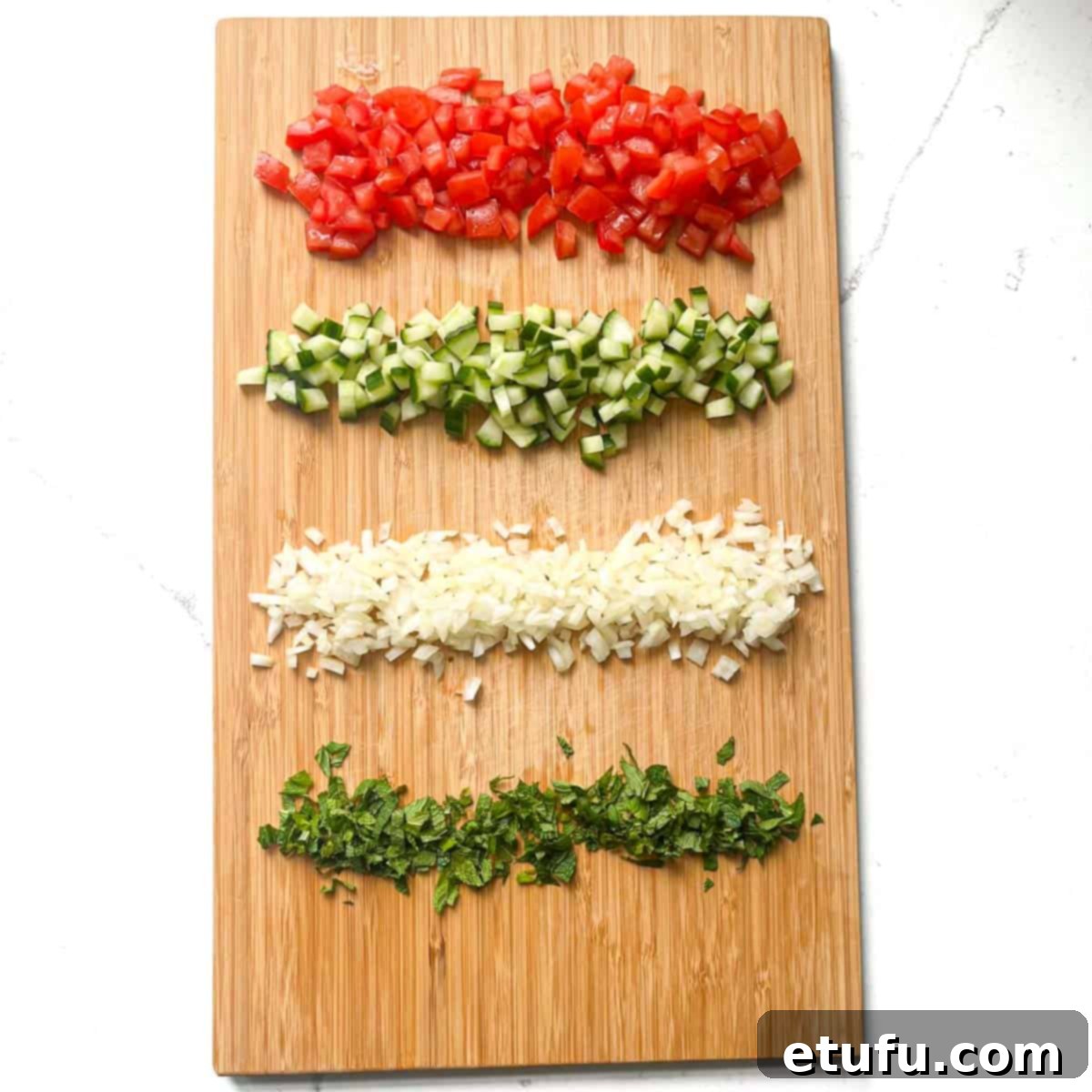

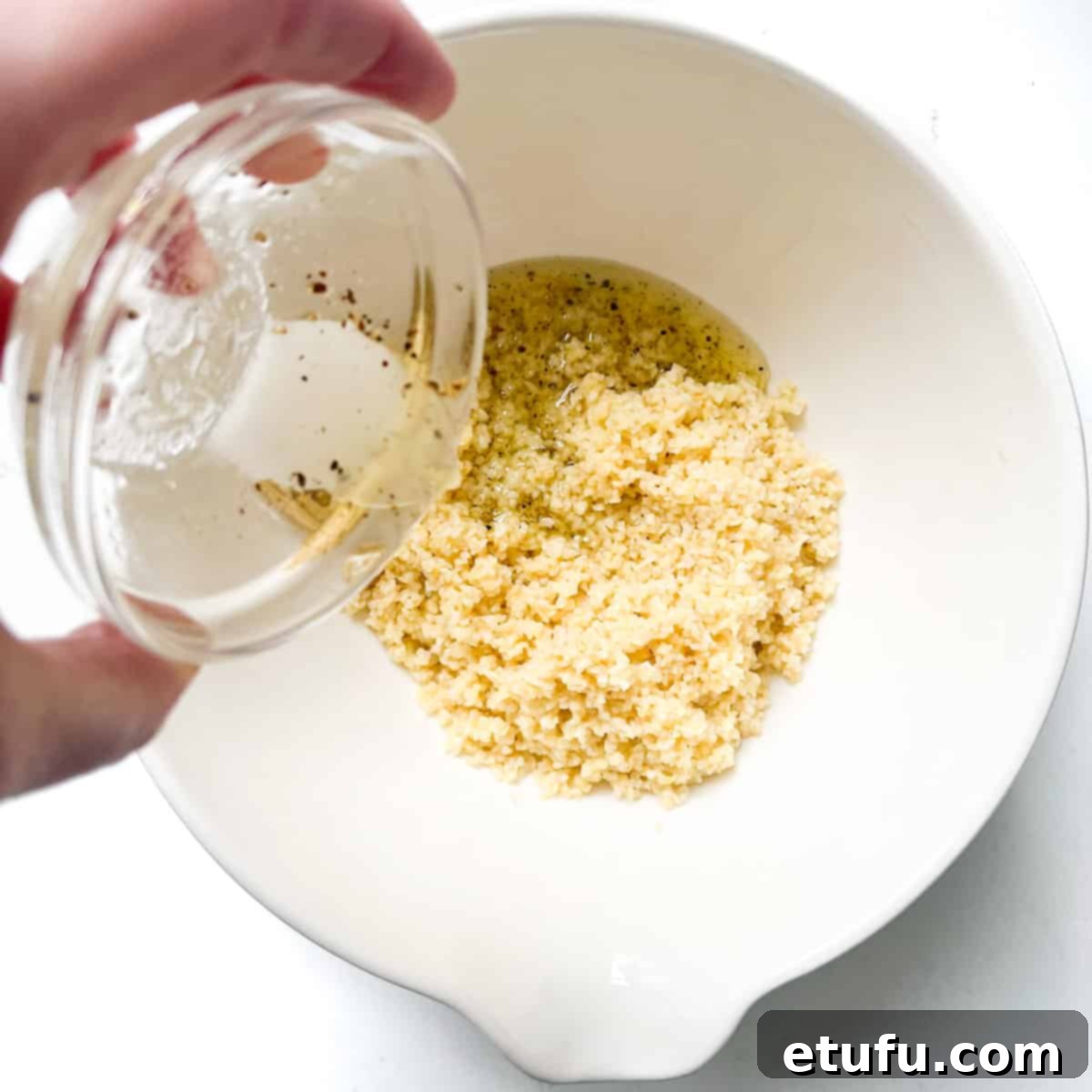
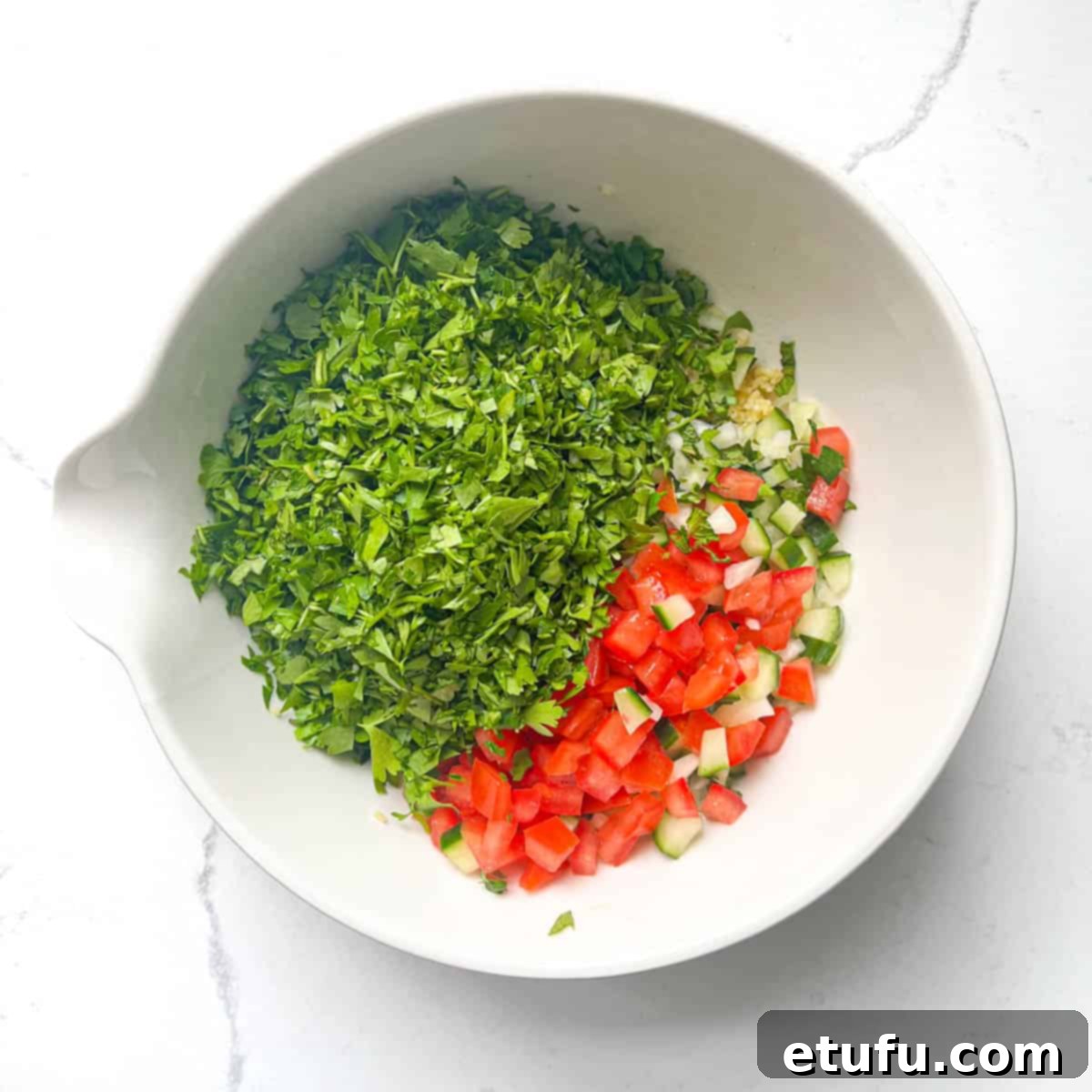
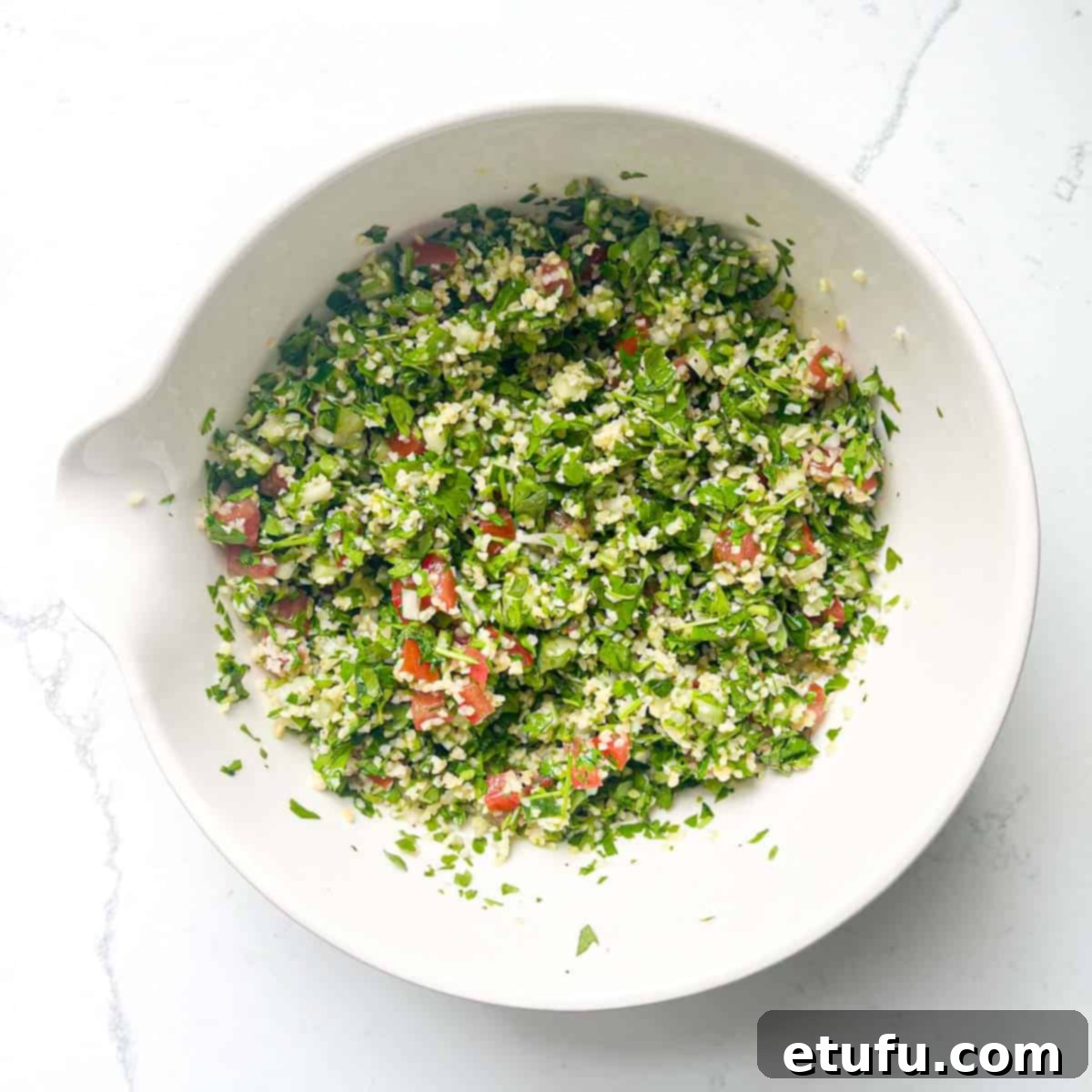
Storage & Make-Ahead Tips for Your Taboule
To keep your Taboule fresh and delicious, proper storage is key. Once prepared, transfer the salad to an airtight container and refrigerate it promptly. When stored correctly, Taboule will maintain its quality for up to 3 days. It’s an excellent make-ahead option for meal prep or entertaining, as the flavors tend to meld and deepen beautifully after a few hours in the fridge.
Before serving chilled Taboule, give it a good stir to redistribute the dressing and ingredients. It’s also a good idea to taste it again for seasoning, as flavors can sometimes mellow in the fridge. Adjust with a little extra salt or a squeeze of fresh lemon juice if needed. If the Taboule appears a bit dry, you can easily revive its freshness by drizzling a small amount of additional extra virgin olive oil and fresh lemon juice over the top, then gently stirring to combine.
Important Note: Taboule is not suitable for freezing. The high water content of the fresh vegetables and the delicate texture of the bulgur wheat can become mushy and unpleasant once thawed, significantly compromising the salad’s signature crispness and vibrancy.
Elevate Your Meal: Inspired Serving Suggestions for Taboule
Taboule’s versatility makes it a fantastic addition to almost any meal. Here are some delightful ways to serve and enjoy this refreshing Lebanese salad:
- Classic Mezze Platter: Incorporate Taboule as a vibrant component of a traditional Middle Eastern mezze platter, alongside creamy hummus, smoky baba ganoush, crispy falafel, warm pita bread, and other small, flavorful dishes.
- Grilling Partner: Serve it as a bright and zesty side dish alongside perfectly grilled meats such as chicken kebabs, lamb chops, beef kofta, or delicate grilled fish and seafood. The freshness cuts through the richness of grilled fare.
- Pita or Cracker Topping: Use Taboule as a fresh, chunky topping for warm pita bread, crispy crackers, or toasted crusty bread for a quick and satisfying snack or appetizer.
- Protein-Packed Main: Transform Taboule into a hearty vegetarian main dish by mixing in cooked chickpeas, lentils, or other beans. This adds satisfying protein and fiber.
- Healthy Lettuce Wraps: For a low-carb and extra fresh option, spoon Taboule into crisp lettuce cups (such as butter lettuce or romaine hearts) or arrange the salad on a bed of fresh lettuce leaves.
- Flavorful Wrap Filling: It makes an excellent, light, and healthy filling for various wraps, whether it’s a whole wheat tortilla, lavash bread, or a simple pita pocket. Add some grilled chicken or feta for extra substance.
- Cheese Topping: Enhance the flavor and texture by topping your Taboule with crumbled feta cheese, goat cheese, or even halloumi cheese for a delicious salty tang.
- Grilled Vegetable Medley: Mix in some perfectly grilled vegetables like tender aubergine (eggplant) slices, zucchini (courgette), bell peppers, or asparagus for added depth and sweetness.
- Colorful Addition: Finely chopped red bell pepper can be added for an extra pop of color, sweetness, and a subtle crunch.
- Stuffed Vegetables: Use Taboule as a delicious and aromatic filling for stuffed red or green bell peppers or ripe tomatoes, baked until tender.
- Grain Bowl Base: Create a nutritious Taboule salad bowl by using a base of cooked quinoa, brown rice, or even additional bulgur, then topping it with a generous portion of Taboule and any other fresh vegetables or protein of your choice.
- Breakfast/Brunch Option: Believe it or not, Taboule can be a refreshing and light addition to a weekend brunch spread, especially when paired with savory egg dishes or yogurt.
Crafting a Gluten-Free Taboule: Absolutely!
For those adhering to a gluten-free diet, enjoying the vibrant flavors of Taboule is entirely possible with a simple substitution. The traditional bulgur wheat, being a wheat product, contains gluten. However, you can easily replace it with excellent gluten-free alternatives that still provide a similar texture and absorb the dressing beautifully.
The most popular and recommended gluten-free alternatives for Taboule are:
- Quinoa: Cooked and cooled quinoa works wonderfully as a bulgur substitute. It’s naturally gluten-free, rich in protein, and has a pleasant, slightly nutty flavor and texture that complements the fresh herbs and vegetables perfectly.
- Gluten-Free Couscous: Many brands now offer gluten-free couscous made from corn, rice, or a blend of gluten-free grains. Be sure to check the package labels to confirm it is certified gluten-free.
- Cauliflower “Rice”: For a grain-free and low-carb option, finely minced raw cauliflower (often called cauliflower “rice”) can be used. It provides a similar textural base and absorbs flavors well, though the taste will be slightly different.
Aside from the bulgur wheat, all other ingredients in this Taboule recipe—fresh parsley, tomatoes, cucumber, onion, mint, olive oil, lemon juice, and pomegranate seeds—are naturally gluten-free. This means you can confidently enjoy this refreshing and healthy salad without any dietary concerns, simply by swapping out the bulgur.
Perfect Pairings: Wines to Complement Your Taboule
Given Taboule’s light, herbaceous, and tangy flavor profile, choosing the right wine can significantly enhance your dining experience. The best wines to pair with Taboule are generally light-bodied, crisp, and refreshing, designed to complement rather than overpower the delicate flavors of the salad.
For white wine lovers, excellent choices include:
- Dry Sauvignon Blanc: Its characteristic high acidity, herbaceous notes, and citrus undertones (often grapefruit or lime) make it an ideal match for the parsley and lemon in Taboule.
- Pinot Grigio (or Pinot Gris): A crisp, dry Pinot Grigio offers refreshing acidity and subtle fruit flavors, providing a clean palate cleanser between bites of the salad.
- Albariño: This Spanish white wine is known for its bright acidity, aromatic notes of citrus and stone fruit, and sometimes a hint of salinity, which beautifully complements the fresh ingredients of Taboule.
- Vermentino: An Italian white known for its bright, saline qualities and citrus zest, perfect for Mediterranean flavors.
If you prefer red wine, opt for very light-bodied and fruit-forward options that won’t clash with the salad’s fresh profile:
- Beaujolais (Gamay): A light and fruity Beaujolais, particularly one served slightly chilled, can be a delightful pairing. Its soft tannins and red berry notes complement the vegetables without overwhelming them.
- Pinot Noir: A very light-bodied, unoaked Pinot Noir with bright cherry and earthy notes can also work well, especially if your Taboule is served alongside grilled chicken or lighter red meats.
Ultimately, the best wine is the one you enjoy most, but these suggestions offer a harmonious balance with the distinct flavors of Taboule.
Middle Eastern vs. French Taboule: Unpacking the Differences
While both Middle Eastern and French versions share the name “Taboule,” there’s a significant distinction in their composition, particularly regarding the bulgur wheat content.
In traditional Lebanese and broader Middle Eastern tabboulehs, parsley is the undisputed star, making up the vast majority of the salad. The bulgur wheat is used sparingly, almost as a binder or a textural element rather than a primary ingredient. The emphasis is on the freshness and abundance of finely chopped herbs (parsley and mint) and diced vegetables, all lightly dressed with lemon juice and olive oil. This results in a vibrant green, intensely herbaceous salad.
Conversely, French tabbouleh (often referred to as “taboulé”) typically features a notably higher proportion of bulgur wheat. In many French preparations, bulgur becomes the most prominent and substantial component of the dish, with the herbs and vegetables playing a secondary role as additions or garnishes. This often makes French taboulé a heartier, more grain-heavy salad, quite distinct from its light, herb-forward Middle Eastern cousin.
More Delightful Side Dishes You Might Enjoy
If you’re looking to expand your culinary repertoire with more delicious side dishes, particularly those with Mediterranean influences or simply great for complementing various meals, here are some fantastic suggestions:
- Roasted Tenderstem Broccoli with Parmesan and Pine Nuts: A simple yet elegant side, boasting tender-crisp broccoli, nutty pine nuts, and savory Parmesan.
- Creamy Carrot and Swede Mash: A comforting and flavorful root vegetable mash, perfect for colder days or as a hearty accompaniment.
- Cypriot Grain Salad: Another refreshing grain-based salad, offering different textures and flavors for variety.
- How to Cook Perfect Couscous Every Time: Master the art of preparing fluffy, flavorful couscous, a versatile base or side for many dishes.
- Sweet and Savory Nectarine Salad with Rocket and Basil Dressing: A unique and refreshing summer salad combining juicy nectarines with peppery arugula.
- Crispy Crumbed Mushrooms: A delightful appetizer or side, offering a satisfying crunch and earthy flavor.
- Spicy Nando’s Style Rice: Bring a kick to your meal with this flavorful and aromatic spicy rice, inspired by popular peri-peri flavors.
- Easy Egyptian Rice with Vermicelli: A classic Middle Eastern rice dish, known for its tender grains and rich flavor from toasted vermicelli.
Recipe: Quick & Easy Traditional Lebanese Taboule
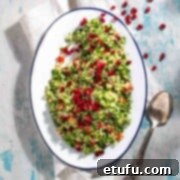
Taboule – Quick and Easy Traditional Lebanese Salad
Taboule is a fantastic traditional Lebanese salad that has been celebrated and enjoyed for centuries throughout the Middle East and far beyond. The use of simple, fresh ingredients like parsley, tomatoes, onion, mint, and bulgur wheat makes Taboule a flavorful and healthy dish that has become hugely popular around the world.
This salad is the ultimate versatile companion for practically any dish, and its fresh, zesty flavor is particularly perfect for a summer gathering or a light, refreshing meal.
Print Recipe
Main Course, Salad, Side Dish
Lebanese
30 minutes
30 minutes
4 generous servings, or 6 smaller servings
220 kcal
Maretha Corbett
Ingredients
- 150 millilitre fine bulgur wheat – or a medium grade bulgur wheat
- 300 millilitre boiling water
- 2 medium tomatoes – finely diced, seeds and pulp removed
- 1 small red or brown onion – roughly 70g, finely chopped
- ¼ medium cucumber – roughly 80g, finely chopped, seeds and pulp removed (optional)
- 500 millilitre finely chopped flat-leaf parsley – roughly 90g fresh parsley. Please note: you will need 500ml (2 cups) of chopped parsley, not 500ml of un-chopped parsley.
- 3 tablespoons finely diced fresh mint – roughly a small handful of leaves
- 3 tablespoons extra virgin olive oil – 45ml, good quality
- 2 tablespoons fresh lemon juice – 30ml, freshly squeezed
- ½ teaspoon salt – 2.5ml, or to taste
- few good grinds black pepper – freshly ground, or to taste
- 3 tablespoons pomegranate seeds – 45ml, for garnish (optional)
Instructions
Add the bulgur wheat to a medium-sized bowl. Pour over the boiling water. Cover the bowl with plastic wrap or a clean kitchen towel and let it soak for 20-30 minutes whilst you prepare the vegetables and herbs.
Slice the tomatoes into quarters and cut out the fleshy middle part containing the seeds. Dice the tomatoes into small pieces of roughly 1cm (⅓ inch).
Note: We remove the pulpy center to prevent adding excess liquid to the salad, ensuring a crisp Taboule.
Dice the onion into small pieces of roughly 1cm (⅓ inch).
If using cucumber, slice it into quarters lengthways and cut out the fleshy middle containing the seeds. Chop into small pieces of roughly 1cm (⅓ inch).
Note: Removing the pulpy center of the cucumber also helps prevent excess liquid in the salad.
Finely chop the parsley.
Tip: Although it may be tempting, we would advise against using a food processor for this step. The parsley might get chopped so finely that it becomes mushy. Just use a big sharp knife or a Mezzaluna for best results.
Finely chop the mint leaves.
In a small bowl, combine the olive oil, fresh lemon juice, salt, and black pepper for the salad dressing. Whisk until emulsified.
Revisit the bulgur wheat. Fluff up the grains with a fork and transfer them to a large salad bowl.
Tip: If you see excess water that hasn’t been soaked up, strain the bulgur through a fine mesh sieve. Shake it from side to side and move the bulgur around with a spoon until all the water has drained away.
Pour the prepared olive oil dressing over the bulgur and give it a quick stir to coat evenly.
Add the diced tomatoes, onions, cucumber (if using), chopped parsley, and mint to the bowl. Gently toss all ingredients through with the bulgur wheat until well combined.
Taste for seasoning and add more salt or pepper if you wish, adjusting to your personal preference.
Scatter the pomegranate seeds generously over the Taboule and serve immediately, or chill for a more refreshing experience.
**Nutritional Data Disclaimer**
Please keep in mind that the nutritional information provided below is calculated by a third party and we cannot guarantee its absolute accuracy. We strive to offer you the most accurate information possible, but we do not take responsibility for any potential errors. Furthermore, the nutritional value of this recipe may vary depending on the exact brands and products you choose to use. For personalized advice on your dietary needs, we recommend consulting with a qualified healthcare professional or a registered dietitian.
Nutrition
For essential food safety advice, including comprehensive guidance on food allergies and proper food handling, please refer to official food safety resources.
More Irresistible Mediterranean Recipes to Explore
Dive deeper into the sun-drenched flavors of the Mediterranean with these additional delightful recipes:
- Spicy Vodka Pasta: A creamy, rich, and slightly spicy pasta dish that has taken social media by storm.
- Easy Fried Courgettes (Fried Zucchini): Simple yet incredibly flavorful, these crispy fried zucchini slices are a perfect side or appetizer.
- Creamy Italian Pasta Salad: A refreshing cold pasta salad, bursting with classic Italian flavors and a creamy dressing.
- Tunisian Orange and Almond Cake: A moist, fragrant, and gluten-free cake, showcasing the beautiful combination of citrus and nuts.
- Panzanella Toscana Salad: The quintessential Tuscan bread and tomato salad, perfect for using up stale bread and ripe summer produce.
- Juicy Greek Roast Chicken with Garlic and Herb Butter: A flavorful and tender roast chicken, infused with aromatic Mediterranean herbs and garlic.
